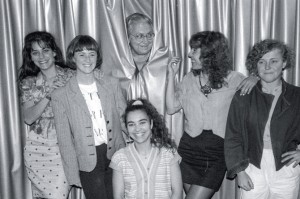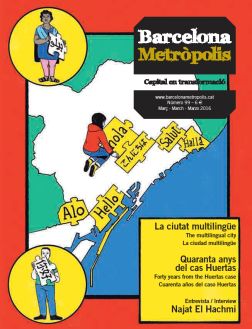2 October will mark a quarter of a century since the death of Maria Aurèlia Capmany (1918-1991), a versatile author who for over 30 years remained at the centre of the cultural scene. She worked in all genres, although her essays on feminism and young people are of particular note.
Today, the multi-faceted work of Maria Aurèlia Capmany and how it was possible for her to create it seem to have passed into history. I can’t think of any current authors among us who are as admirably versatile. A versatility encouraged by the cultural world for three and a half decades, from the mid-1950s right up to the end of the 1980s, during which time Capmany brought out novel after novel, article after article. Nowadays you would need to be Basque to take advantage of a public and private climate that would allow an author to work in different genres and even intermingle them in the same book – novels, essays, stories, poetry, theatre, song lyrics, scripts for comics and feature and television films, translations, memoirs and diaries, articles in newspapers and magazines –, to have so many readers and to be translated. Capmany did all of the above, except for books of poems (although song lyrics are poetry) and film scripts.
As a precise indicator of the cultural changes for the worse in this quarter century, her essays on feminism and the new role of young people are particularly worthy of attention. Formidable in terms of timeliness, they defined an era. And they were written at the request of a publisher! Wouldn’t an update be equally necessary today, when generational changes and mentalities are going in this dual direction, no matter how many obstacles might be encountered? If that did happen, though, I don’t know whether there would be any publisher that would commission them from an intellectual.
La dona a Catalunya: consciència i situació [Women in Catalonia: awareness and situation] was published half a century ago now, in 1966, also the year of “La Caputxinada”, the constituent assembly of the University of Barcelona’s Democratic Students’ Union, held at the Capuchin convent in Sarrià (Barcelona), in which the author took part. Maria Aurèlia – as many called her, proof of the recognition and popularity she earned and won – had been a well-regarded writer since the publication of her first novel, Necessitem morir [We need to die] (1952), completed in 1947. An allegorical novel about those years of transformation and cultural recovery, written by a 30-year-old woman who had lived through the war and the harsh initial post-war period, a failure, as she mercilessly categorises herself in her memoirs, resolutely determined not to forget it while at the same time not complaining about it.

Maria Aurèlia Capmany with members of the theatre-cabaret group Oli de Boges, at the performance of one of her works at the legendary theatre La Cova del Drac in 1989.
Photo: Robert Ramos.
She was also a woman of the theatre, an author and actress. A teacher, an anti-Franco and pro-Catalan activist, a woman going against the flow who, with a keen eye and a sharp tongue, was increasingly in the limelight. A woman with bohemian ways and more. She wasn’t a beatnik, but she began to spread the American crime novel and provided a glimpse of the nascent counterculture, as would soon be seen. A child of Barcelona’s Rambla de les Flors.
Her book on feminism was valuable. Reading it today, it is perfectly reasonable to see it as an early example of the cultural studies then developing in the English-speaking academic world. Capmany provided a good critical review of the context and women of the educated petite bourgeoisie of the early 20th century, the prudent feminism that would always drive her crazy. But she also rescued them from the abyss and from cultural nothingness. The Barcelonians Dolors Monserdà, an author, and Francesca Bonnemaison, an educator and promoter of female education, sprung back into life. Three years after this historical plunge into a past that was so opaque it seemed empty, she submerged herself in the present.
And she emerged with La joventut és una nova classe? [Are young people a new class?], devoting the same attention to popular culture and analysis that avoids making the elite the central focus for this exploration. This was also published by Edicions 62, a publishing project that at that time had become a reality, which, seen from today, was glorious. It did not punish intelligence and boldness; on the contrary, it encouraged them.
This span covering interests ranging from the cultural history of modernity to the country’s present and the vibrations in the western world, despite Franco’s dictatorship, would put her in the public eye even more with articles in newspapers and magazines. Capmany was a well-informed author, with knowledge of languages and other cultural landscapes such as France, Italy and the United States, where statuses were being stirred and new understandings roused. It was known she was multifaceted, but when she published her books on feminism and then on young people an author appeared whose scope went beyond novels, a genre she would continue to cultivate but which would gradually become just another of the many areas in which she worked. A mention must be made of her theatrical involvements, particularly as an actress with the Adrià Gual company, contributing greatly to accompany the works of Salvador Espriu. There was also her work as an author, with works as stunning as 1971’s Preguntes i respostes sobre la vida i la mort de Francesc Layret, advocat dels obrers de Catalunya [Questions and answers on the life and death of Francesc Layret, advocate for Catalonia’s workers], co-written with Xavier Romeu.
In sum, Capmany was above all an intellectual who, luckily for herself and for us, found herself in a wonderful cultural context when she entered adulthood. Today, the essay is a chimera for many authors, as is prose itself if it does not take the form of a novel or memoir, and even then. A talented author, who writes very well, a writer of prose who is completely out of the ordinary, contrary to the stereotype, clearly attentive to the expressions of everyday life and of the senses themselves, a born arguer, a provoker of words. These are qualities that link her with two contemporaneous authors who were exclusively prose writers, as if they were French or Italian, thanks to their shared moment in publishing and politics, to the varied cultural revolution, which expressed itself as it could and which brought them together from different angles: Josep Pla and Joan Fuster. It really doesn’t matter if they had it in for each other, if they had any kind of relationship or not. We are the ones who read them (if we do); we are the ones who finish the books or put them aside, talk about them or not, make them come back to life or not. We hear people talking about Pla nearly all the time; less (too little) about Fuster; and almost never about Capmany. They should ask us why.
The “I” and the “we”. That is the central point, I note, of Capmany’s work. Her later books of memoirs are, in this sense, a literary document and a moral indictment about the life of a woman and a culture that, in order to continue being of their time, modern, have seen it all. They exude the intelligence of speaking without saying everything, leaving readers the space and responsibility that falls to us and to which we are entitled. We will not know much about the author of these books, about her difficult childhood and youth, about her even more difficult old age. We will know, on the other hand, if we want to, much more about ourselves.
She wrote these books when she was a staunch socialist and had reached a position of considerable public standing. A woman who, during the heated (politically and even more so meteorologically) Míting de la Llibertat [Freedom Meeting] of 1976 (the first major mass act of the transition period, representing the formal start of the process towards forming the new Socialist Party of Catalonia) at Montjuïc in Barcelona, when not even the Communists were legal, shouted to the drenched crowd: “We sweat socialism!” The councillor for culture who would accompany Mayor Maragall for years. She then wrote Dietari de prudències [Diary of prudence] (1981), Mala memòria [Bad memory] (1987), finishing with Això era i no era [It was and was not] (1989) when she was already suffering from cancer. Together with earlier memoir works, the two volumes of Pedra de toc [Touchstone] (1970-1974), they form an invaluable compendium about how to reconnect “I” and “we”. Something which is still so badly needed.
Here’s to Maria Aurèlia!





